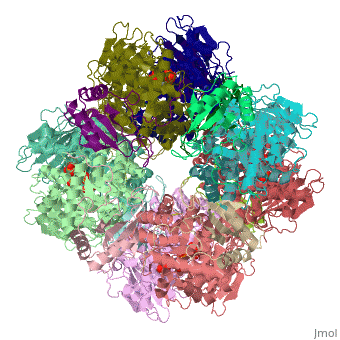Calvin cycle
From Proteopedia
See also [1] and Carbon Fixation. 3 CO2 + 6 NADPH + 6 H+ + 9 ATP + 5 H2O → glyceraldehyde-3-phosphate (G3P) + 6 NADP+ + 9 ADP + 8 Pi (Pi = inorganic phosphate) (See also [2]) Step 1 The enzyme RuBisCO catalyses the carboxylation of , RuBP, a 5-carbon compound, by carbon dioxide (a total of 6 carbons) in a two-step reaction. The product of the first step is enediol-enzyme complex that can capture CO2 or O2. Thus, enediol-enzyme complex is the real carboxylase/oxygenase. The CO2 that is captured by enediol in second step produces an unstable six-carbon compound called 2-carboxy 3-keto 1,5-biphosphoribotol (CKABP) (or 3-keto-2-carboxyarabinitol 1,5-bisphosphate) that immediately splits into 2 molecules of , a 3-carbon compound. Step 2 The enzyme phosphoglycerate kinase catalyzes the phosphorylation of 3-PGA by ATP (which was produced in the light-dependent stage). (glycerate-1,3-bisphosphate) and ADP are the products. Step 3 The enzyme glyceraldehyde-3-phosphate dehydrogenase catalyzes the reduction of by NADPH (which is another product of the light-dependent stage). (also called G3P, GP, TP, PGAL, GAP) is produced, and the NADPH itself is oxidized and becomes NADP+. Again, two NADPH are utilized per CO2 fixed. This reaction is reverse to that in the glycolysis. The next stage in the Calvin cycle is to regenerate RuBP. Five G3P molecules produce three RuBP molecules, using up three molecules of ATP. Since each CO2 molecule produces two G3P molecules, three CO2 molecules produce six G3P molecules, of which five are used to regenerate RuBP, leaving a net gain of one G3P molecule per three CO2 molecules (as would be expected from the number of carbon atoms involved). The regeneration stage can be broken down into a series of steps: 1) Triose phosphate isomerase converts all of the G3P reversibly into , also a 3-carbon molecule. 2) Aldolase and fructose-1,6-bisphosphatase convert a G3P and a DHAP into (6C). A phosphate ion is lost into solution. 3)Then fixation of another CO2 generates two more G3P. 4) has two carbons removed by transketolase, giving . The two carbons on transketolase are added to a , giving the ketose . 5) E4P and a DHAP (formed from one of the G3P from the second CO2 fixation) are converted into sedoheptulose-1,7-bisphosphate (7C) by aldolase enzyme. 6) Sedoheptulose-1,7-bisphosphatase (one of only three enzymes of the Calvin cycle that are unique to plants) cleaves sedoheptulose-1,7-bisphosphate into , releasing an inorganic phosphate ion into solution 7) Fixation of a third CO2 generates two more G3P. The ketose S7P has two carbons removed by transketolase, giving , and the two carbons remaining on transketolase are transferred to one of the , giving another . This leaves one G3P as the product of fixation of 3 CO2, with generation of three pentoses that can be converted to Ru5P. 8) R5P is converted into (Ru5P, RuP) by phosphopentose isomerase. Xu5P is converted into RuP by phosphopentose epimerase. 9) Finally, phosphoribulokinase (e.g. Crystal structure of phosphoribulokinase from Synechococcus sp. strain PCC 6301) phosphorylates RuP into RuBP, , completing the Calvin cycle. This requires the input of one ATP. Light-dependent regulation These reactions do not occur in the dark or at night. There is a light-dependent regulation of the cycle enzymes, as the third step requires NADPH. There are two regulation systems at work when the cycle must be turned on or off: the thioredoxin/ferredoxin activation system, which activates some of the cycle enzymes; and the RuBisCO enzyme activation, active in the Calvin cycle, which involves its own activase. The thioredoxin/ferredoxin system activates the enzymes glyceraldehyde-3-phosphate dehydrogenase, glyceraldehyde-3-P phosphatase, fructose-1,6-bisphosphatase, sedoheptulose-1,7-bisphosphatase, and ribulose-5-phosphatase kinase, which are key points of the process. This happens when light is available, as the ferredoxin protein is reduced in the Photosystem I complex of the thylakoid electron chain when electrons are circulating through it.
| |||||||||||

